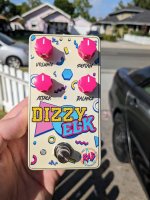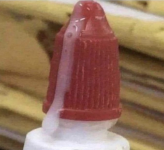peccary
Well-known member
Hey folks,
It's been quite a while since I've finished a pedal and I am pretty proud of this one.
Before getting into it, though, I owe a lot of people thanks. This is really just a continuation of the NPN Gnat mod that I became somewhat obsessed with a while back after talking to @Guardians of the analog and getting educated a bit on the different fuzz circuits out there. After asking about an NPN mod for it, @music6000 graciously posted up a modified Gnat layout and I took it form there.
I ended up building six or so of these, giving them all away to friends. I wanted to build one for myself but had the idea of making my own PCB with the "Get Rad!" logo on it, so I reached out to @bean and he took on the commission of doing the layout work and everything for me so that I could put an order in to have my own PCBs made.
After sending out an order to JLC I needed some artwork and reached out to @SYLV9ST9R who (again!) created some really radical artwork for me for this project.
I can't stress enough how *little* I actually had to do with this, other than just pooling resources that were already available and reaching out to really awesome people in this lovely DIY community. I've always maintained that I'm really just an overgrown ape who learned to solder - you all are who allow me to do rad things, and I really appreciate it. I also need to shout out to my boys @Harry Klippton , @Paradox916 , @blackhatboojum , and (again) @Guardians of the analog , who have been my cheer leaders through this, keeping me motivated and on task. Thanks again, everyone.
This is the Dizzy Elk, a Dizzy Tone which uses NPN transistors.
I ended up tuning this one down a little bit, using lower hFE transistors for Q1 and Q2. Doing this allowed me to tune this so that it worked really well with my bass (P-Bass with flatwounds) as well as with my guitar. Since I am mainly a bassist who uses flats I wanted it to be a little less wild than usual. It's still pretty wild, but the edge being taken off helps tilt it to be a *bit* more bass friendly. Either way though, this circuit is very good on bass, maintaining lots of fatty low end, which I find surprising for most fuzz pedals.
I typically use D9V diodes for the GE diode here, but I found that my higher leakage 104NU71 transistors actually make excellent diodes for this, so that's what I ended up using there. And they look pretty rad.
The artwork is a no-film waterslide and it came out fantastic if I do say so myself. I made a mistake when preparing the file to print and deleted the power label and didn't notice till after I'd put it on the enclosure, but I can live with that. Next one will have it on there.
That said, here it is:


I included some sound clips as well. All of these were recorded direct into an A&H ZEDi10FX mixer into Reaper. The only effect used is the Dizzy Elk.
I am a terrible guitar player and am almost embarrassed to post these, but this post deserves sound clips regardless of my embarrassment, so here they are:
I was walking to work the other day and What's the Frequency Kenneth? came on my Spotify playlist and my god if it just didn't sound really close to this. I don't do the song justice, but I think you'll know what I mean:
So I did a terrible job with this - I don't have the subtlety to really nail this, but again, I think you can see why my brain thought this was appropriate for this pedal. I know that nothing *really* sounds like Spirit in the Sky, but I bet some of you could tweak this and with better technique get a lot closer than I can:
This last one is just me noodling for a little bit on bass. This is me slapping (!) on a P-Bass (!) with flats (!) - that sentence would get me thrown into the brig on Talk Bass, but this pedal makes it possible. A compressor is needed for sure (these were all recorded with only the Dizzy Elk) but the bass comes through really well here, and even the strumming is articulated fairly well. I think that's kind of amazing for how intense this pedal can be. YMMV.
It's been quite a while since I've finished a pedal and I am pretty proud of this one.
Before getting into it, though, I owe a lot of people thanks. This is really just a continuation of the NPN Gnat mod that I became somewhat obsessed with a while back after talking to @Guardians of the analog and getting educated a bit on the different fuzz circuits out there. After asking about an NPN mod for it, @music6000 graciously posted up a modified Gnat layout and I took it form there.
I ended up building six or so of these, giving them all away to friends. I wanted to build one for myself but had the idea of making my own PCB with the "Get Rad!" logo on it, so I reached out to @bean and he took on the commission of doing the layout work and everything for me so that I could put an order in to have my own PCBs made.
After sending out an order to JLC I needed some artwork and reached out to @SYLV9ST9R who (again!) created some really radical artwork for me for this project.
I can't stress enough how *little* I actually had to do with this, other than just pooling resources that were already available and reaching out to really awesome people in this lovely DIY community. I've always maintained that I'm really just an overgrown ape who learned to solder - you all are who allow me to do rad things, and I really appreciate it. I also need to shout out to my boys @Harry Klippton , @Paradox916 , @blackhatboojum , and (again) @Guardians of the analog , who have been my cheer leaders through this, keeping me motivated and on task. Thanks again, everyone.
This is the Dizzy Elk, a Dizzy Tone which uses NPN transistors.
I ended up tuning this one down a little bit, using lower hFE transistors for Q1 and Q2. Doing this allowed me to tune this so that it worked really well with my bass (P-Bass with flatwounds) as well as with my guitar. Since I am mainly a bassist who uses flats I wanted it to be a little less wild than usual. It's still pretty wild, but the edge being taken off helps tilt it to be a *bit* more bass friendly. Either way though, this circuit is very good on bass, maintaining lots of fatty low end, which I find surprising for most fuzz pedals.
I typically use D9V diodes for the GE diode here, but I found that my higher leakage 104NU71 transistors actually make excellent diodes for this, so that's what I ended up using there. And they look pretty rad.
The artwork is a no-film waterslide and it came out fantastic if I do say so myself. I made a mistake when preparing the file to print and deleted the power label and didn't notice till after I'd put it on the enclosure, but I can live with that. Next one will have it on there.
That said, here it is:


I included some sound clips as well. All of these were recorded direct into an A&H ZEDi10FX mixer into Reaper. The only effect used is the Dizzy Elk.
I am a terrible guitar player and am almost embarrassed to post these, but this post deserves sound clips regardless of my embarrassment, so here they are:
I was walking to work the other day and What's the Frequency Kenneth? came on my Spotify playlist and my god if it just didn't sound really close to this. I don't do the song justice, but I think you'll know what I mean:
So I did a terrible job with this - I don't have the subtlety to really nail this, but again, I think you can see why my brain thought this was appropriate for this pedal. I know that nothing *really* sounds like Spirit in the Sky, but I bet some of you could tweak this and with better technique get a lot closer than I can:
This last one is just me noodling for a little bit on bass. This is me slapping (!) on a P-Bass (!) with flats (!) - that sentence would get me thrown into the brig on Talk Bass, but this pedal makes it possible. A compressor is needed for sure (these were all recorded with only the Dizzy Elk) but the bass comes through really well here, and even the strumming is articulated fairly well. I think that's kind of amazing for how intense this pedal can be. YMMV.
Last edited:





